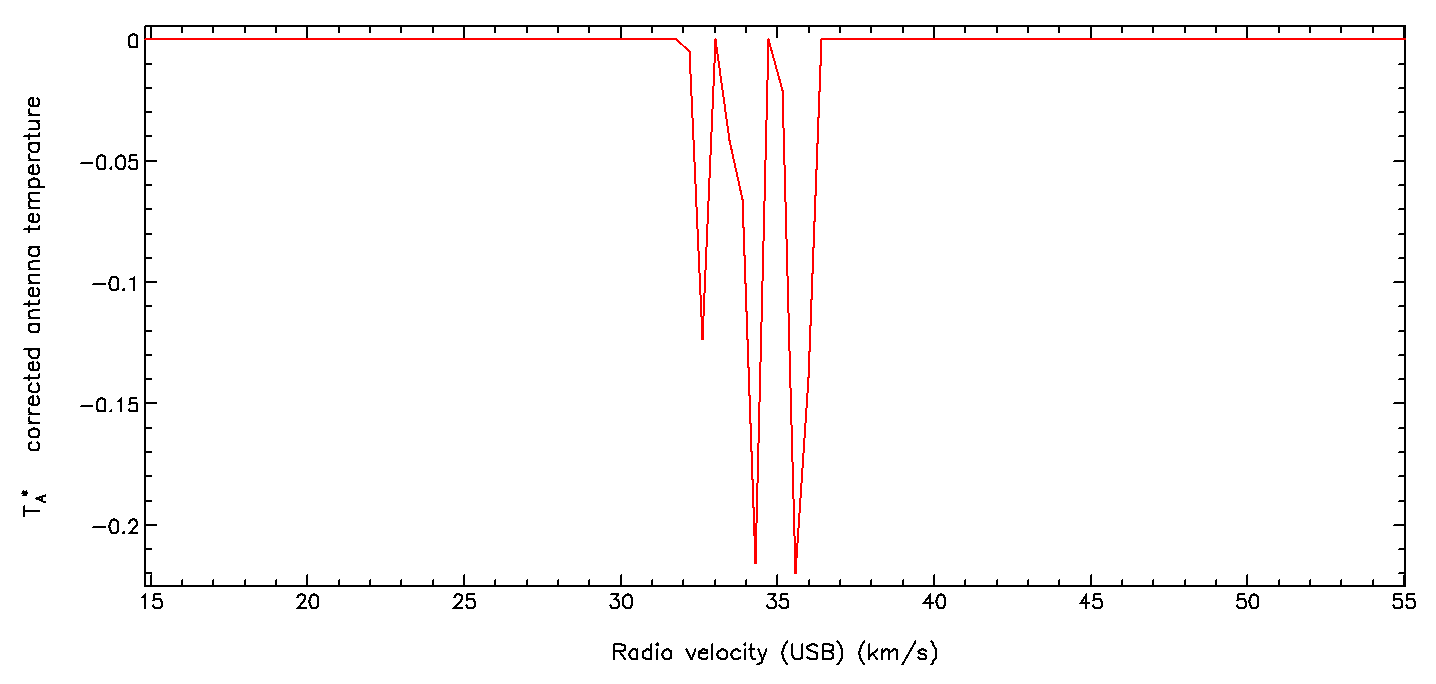Loading [MathJax]/jax/output/HTML-CSS/jax.js
- ←Prev
- The Heterodyne Data Reduction Cookbook
-
- TOC ↑
Appendix I
Removal of reference signal
During heterodyne observations, the telescope switches (see Section 3.3.2) between observing your target and a
nearby reference position. The latter’s spectrum is subtracted from the target data in order to subtract the
sky-background signal.
In most cases, this reference location will be devoid of source emission. However, around the Galactic Plane and
especially the Galactic Centre, it can be problematic to find a reference position that’s pointing at sky, even with
a position switch. Should the reference measurement include a source, its signal will be subtracted from all the
spectra in your data, appearing one or more absorption lines. If the absorption occurs where your
target has strong emission across a wide range of frequencies, the absorption feature can easily be
camouflaged. Even it is located where there is weak or no target signal, a strong absorption feature
will slightly bias the baseline fitting. So if your data has such artefacts, it is worth trying to correct
them.
A simple approach for removal is to interpolate across the absorption feature, but this does assume that the
target emission is not varying across the width of the absorption line or lines. If the absorption is
located clear of your source’s emission, it is possible to merely mask the feature with chpix. The
following example masks all spectra witihn the time-series cube ts_cube between 3.5 and
7.8 km s−1.
% chpix ts_cube ts_cube_refmasked section="’3.5:7.8,,’" bad
The basis of a better method is to attempt to determine the reference spectrum. One such approach is to
identify regions with none or minimal target emission in your reduced spectral cube, mask these,
then form the median spectrum of the remainder. Regions to include or exclude may be defined
with ARD regions in a text file, possibly created with Gaia(see Section 8.8); or using the shape
selection in the Gaia cube-manipulation controls, especially the polygon (see Figure I.1). The resultant
spectrum may be saved (see Figure I.2). In practice this median spectrum will likely still have
some target emission and possibly a non-flat baseline, which need to be removed. One approach
is to smooth the spectrum with a wide kernel—essentially a low-pass filter—and then subtract
the smoothed spectrum from the original. Finally, since we are only interested in the aborption
features, set all the non-line elements to 0. In the Figure I.2 example that is between 4.7 and 6.3
km s−1.
% block median_sky_spectrum smoothed_spectrum 21
% sub median_sky_spectrum smoothed_spectrum flat_spectrum
% chpix flat_spectrum ref_spectrum section="’:4.7,6.3:’" 0
To apply this to your cube, enlarge it to the dimensions of your cube. The value of the AXES parameter will
depend on whether you intend to subtract the reference spectrum from the raw time series, or from the
position-position-velocity (PPV) reduced cube. For the time series
% manic ref_spectrum ref_ts_cube axes="[1,0,0]" lbound="[1,1]" ubound="[14,4202]"
and for the PPV
% manic ref_spectrum ref_ppv_cube axes="[0,0,1]" lbound="[-122,-124]" ubound="[126,125]"
AXES specifies the axis to retain (1) or new dimensions to grow (0). The pixel bounds of the new axes are given
repectively by LBOUND and UBOUND arrays. In the time-series example, there are 14 receptors and 4202 spectra.
You can find the bounds of your cube with ndftrace.
% ndftrace cube | grep "Pixel bounds"
I.1 Remove the reference signal using ORAC-DR
A number of recipe parameters are provided for the attempted removal of reference signal, and are listed
in Table G.12. For Galactic Plann surveys the following combination have worked moderately
well.
CLUMP_METHOD = clumpfind
SUBTRACT_REF_EMISSION = 1
REF_EMISSION_MASK_SOURCE = both
REF_EMISSION_COMBINE_REFPOS = 1
REF_EMISSION_BOXSIZE = 19
You may need to enlarge REF_EMISSION_BOXSIZ should your data have narrow velocity channels. An example
of using these settings that successfully removed the reference signal from some Galactic Plane data is shown in
Figure I.4.
The algorithm used by Orac-dr does not always remove all of the lines, and in rare cases leaves lines
unchanged. For these recalcitrant lines some additional facilities are provided, where you set the velocity limits
of the reference absorption line.
SUBTRACT_REF_SPECTRUM = 1
REF_SPECTRUM_COMBINE_REFPOS = 1
REF_SPECTRUM_REGIONS = 7.6:13.8
REF_SPECTRUM_REGIONS sets a comma-separated list of the velocity ranges of the absorption lines.
If that does not work, you can provide your own estimated reference spectrum, containing zeroed data values
outside of the line extent, as described earlier and shown in Figure I.3. You then supply its file name using the
recipe parameter shown below.
REF_SPECTRUM_FILE = ref_spectrum
The algorithms used are described in a forthcoming COHRS [13] Second Release paper.
Copyright © 2015-2025 Science and Technology Facilities Council,
& East Asian Observatory
- ←Prev
- The Heterodyne Data Reduction Cookbook
-
- TOC ↑



